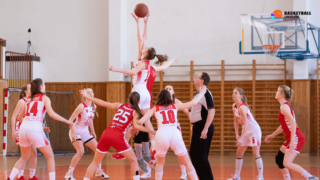
If you’ve found yourself wondering just how long a middle school basketball game can last, you’ve come to the right place! As future basketball stars in the making, middle schoolers are known to bring infectious energy to the court, making for some thrilling games. In this blog post, we’ll dive into the ins and outs of middle school basketball, covering its duration, format, and other fun facts worth knowing. So, lace up your sneakers and get ready to explore the fast-paced world of middle school basketball with us!
How Long Is a Middle School Basketball Game?
A typical middle school basketball game lasts for about 60 to 90 minutes, consisting of four quarters with a duration of six to eight minutes each. Factors affecting game length include timeouts, breaks between quarters, and halftime, which may vary depending on the league and specific regulations.
Breaking Down Middle School Basketball Game Length
Now that we have a general idea of how long middle school basketball games last, let’s delve into the details. A thorough understanding of the factors affecting game length, from timing and regulations to the impact of timeouts and breaks, will give you a comprehensive grasp of what to expect when attending or planning your middle schooler’s basketball games.
Quarters and Overtime
Middle school basketball games are typically divided into four quarters, with each quarter lasting six to eight minutes, depending on the league and specific rules. This means that the entirety of regulation time ranges from 24 to 32 minutes. It’s also important to note that if the game ends in a tie, an additional period called “overtime” may be added to determine the winner. Overtime periods usually last for around four minutes.
Breaks Between Quarters and Halftime
Between quarters, breaks allow the players to catch their breath and regroup for the next section of the game. In most middle school basketball games, the break between the first and second quarters and the break between the third and fourth quarters are about two minutes long. However, the halftime break, which occurs between the second and third quarters, is usually longer—typically lasting around 10 minutes. This makes for a combined break time of about 14 minutes.
The Impact of Timeouts
A crucial aspect of the game that directly affects how long a middle school basketball game lasts is the use of timeouts. Timeouts are an essential part of basketball, allowing coaches and players to strategize, adjust their tactics, and refocus during the game.
Regular Timeouts
In most middle school basketball games, each team is allowed a specific number of timeouts per game. This number can range from three to five, depending on the league and level of play. Generally, regular timeouts are 60 seconds, although some leagues might allow for a 30-second timeout in addition to, or as a replacement for, full timeouts.
Referee Timeouts
Sometimes, a referee might call a timeout for various reasons, such as addressing an injury or handling an equipment issue. These timeouts tend to be brief and generally do not last more than a couple of minutes. However, they can still affect the overall length of the middle school basketball game.
The Role of Fouls and Free Throws
Another factor contributing to the duration of a middle school basketball game is the fouls and subsequent free throws. When a player is fouled while shooting or after their team has accumulated a certain number of fouls, the player gets to take one or more free throws—uncontested shots from the free-throw line. Each free throw theoretically can take around 10 seconds but can last longer, considering the time taken to reset players and substitutions.
Bonus Situations
When a team accumulates a specific number of fouls within a half, it is said to be “in the bonus.” This means that any subsequent fouls committed by the team will result in the opposition shooting free throws, regardless of whether the fouled player was in the act of shooting. This increases the frequency of free throws in a game, which can also have a significant impact on the duration of a middle school basketball game.
Factors Varying by League and Location
Understanding the length of middle school basketball games can be complex, as some factors depend on the league or location where the games are being played. Different leagues may have specific rules regarding the length of quarters, timeouts, breaks, and other game elements, which can influence game duration.
State and Regional Differences
Each state or region might have distinct rules governing middle school basketball. For example, a middle school basketball league in California might have shorter quarters, whereas a league in Texas might opt for longer quarters. It is essential to familiarize yourself with local regulations in order to understand the exact duration of basketball games in your middle schooler’s league.
Tournament Play
During tournaments or playoffs, middle school basketball game rules can undergo slight changes, with the game length possibly being affected. For instance, there might be adjustments to the number of timeouts, length of breaks, or even the duration of quarters. It is crucial to be aware of such variations to prepare for the potential differences in game length during such events.
The Effect of Skill Level and Game Flow
The length of a middle school basketball game can also be connected to the skill level of the players and the overall flow of the game. A highly skilled, fast-paced game with fewer fouls and stoppages might finish quicker, while a slower-paced game with frequent fouls and interruptions might take longer to complete.
Ball Handling and Turnovers
Middle school basketball games involving highly skilled players would typically have fewer turnovers or other disruptions in the game flow. As a result, the game could end up being shorter. On the other hand, games with many turnovers or inexperienced players might take longer to complete, as frequent stoppages or pauses in the flow of play can contribute to the time elapsed.
Defensive Strategies and Foul Troubles
Defensive strategies can have a significant impact on how long the game lasts. If a team employs an aggressive full-court press, it could lead to more fouls, which in turn result in more free throws and a longer game. However, if both teams opt for a more conservative defensive approach, resulting in fewer fouls, the duration of the middle school basketball game might be shorter.
Preparing for Middle School Basketball Games
Now that you have a better idea of how long a middle school basketball game might take and the factors affecting its duration, you can plan your time accordingly. Whether you are a family member, friend, coach, or player, time management is essential for a seamless basketball experience.
Arriving Early
It is always a good idea to arrive at the basketball court well in advance of the scheduled game time. This allows the players to warm up and get ready, while family and friends can secure their spots in the stands. Additionally, arriving early provides enough time to handle any unforeseen circumstances, such as a delayed start or last-minute location change.
Post-Game Responsibilities
After the game, it is essential to consider post-game responsibilities, such as gathering personal belongings, cooling down, discussing the game with the coach, or even attending a short team meeting. Allocating enough time for these tasks can make the overall experience less stressful and more enjoyable.
Embracing the Middle School Basketball Experience
Middle school basketball games provide an excellent opportunity for young athletes to hone their skills, forge friendships, and learn valuable lessons both on and off the court. As a parent, friend, or coach, understanding the ins and outs of basketball game length can help foster a positive environment for growth and enjoyment. Embrace the energy and excitement of middle school basketball, and most importantly, have fun!
Key Considerations for Planning and Participation
When it comes to middle school basketball games, not only is it essential to know how long the games last, but also to consider other factors that can ensure a positive and enjoyable experience for everyone involved. In this section, we will explore some additional aspects and tips to help you make the most out of every game.
Understanding Age Group Differences
It’s essential to consider that middle schoolers cover a broad range of ages, typically from grades 6 to 8. As a result, variations in game duration, rules, and even equipment could arise depending on the age group your middle school athlete falls into. Be sure to check league-specific information for each age group to better comprehend and adapt to their unique play circumstances.
Managing Pre-Game Nutrition and Hydration
For young athletes to perform at their best during basketball games, it’s crucial to ensure they receive proper nutrition and hydration. Providing a balanced meal a few hours before game time can help fuel their bodies for optimal performance. Supplying water or sports drinks during breaks and timeouts can also prevent dehydration and help athletes stay alert throughout the game.
Incorporating Rest and Recovery
Given the intensity and duration of middle school basketball games, it’s crucial to prioritize rest and recovery for the athletes. Warming up before games and cooling down afterward can help reduce the risk of injuries and promote overall well-being. Additionally, incorporating rest days and emphasizing the importance of adequate sleep can contribute to an athlete’s overall health and success on the court.
Emphasizing Sportsmanship and Teamwork
Middle school basketball is not only about physical performance but also about learning essential life skills such as sportsmanship, teamwork, and perseverance. Encourage athletes to interact positively with teammates, opponents, coaches, and referees regardless of the game’s outcome. This promotes a healthy and friendly environment for everyone involved and contributes to personal growth and development beyond the basketball court.
Frequently Asked Questions
In this FAQ section, we’ll be addressing common questions and concerns about middle school basketball game length and other related topics. We aim to provide concise, informative answers to help you better understand and navigate the world of middle school basketball.
1. What is the standard length of a middle school basketball quarter?
A typical middle school basketball quarter lasts between six and eight minutes. However, this duration may vary depending on the specific league, region, and age group of the players.
2. How many timeouts are allowed in middle school basketball games?
Most middle school basketball games allow each team to have three to five timeouts per game. The exact number may vary depending on the league and level of play.
3. How long are middle school basketball timeouts?
Regular timeouts in middle school basketball games usually last for 60 seconds, though some leagues may also include a 30-second timeout option.
4. What is the duration of a halftime break in middle school basketball?
The halftime break in middle school basketball typically lasts around 10 minutes. This break occurs between the second and third quarters of the game.
5. How long is a middle school basketball overtime period?
An overtime period in middle school basketball usually lasts for four minutes. Overtime is added when the game ends in a tie during regulation time to determine the winner.
6. How many fouls are allowed before a team is considered “in the bonus”?
A team is considered “in the bonus” when it accumulates a specific number of team fouls within a half. The exact number may vary depending on the league, but it typically ranges from seven to ten fouls.
7. What is a technical foul, and how does it affect game length?
A technical foul is a violation assessed for unsportsmanlike conduct or other rule violations not involving player contact. When a technical foul is called, the opposing team is awarded two free throws, and the game clock stops, which can affect the overall game length.
8. How do middle school basketball games differ from high school games in terms of length?
High school basketball games generally have longer quarters, timeouts, and breaks compared to middle school games. Additionally, high school games often involve more advanced skills and strategies, which can also impact game duration.
9. Can a middle school basketball game end in a tie?
No, middle school basketball games do not usually end in a tie. If the game remains tied at the end of regulation time, one or more overtime periods are added until a winner is determined.
10. How does the shot clock work in middle school basketball?
Not all middle school leagues use a shot clock. However, if a shot clock is in use, it usually lasts for 24 to 35 seconds. Teams must shoot and hit the rim within the shot clock limit to avoid a violation. The use of a shot clock can impact game duration by encouraging a faster pace of play.
11. Is there a “mercy rule” in middle school basketball?
Some leagues may have a “mercy rule” that requires the game to end early if one team leads by a significant margin. Rules and margins can vary between leagues; always refer to your specific league’s guidelines to understand the application of the mercy rule.
12. How long should I expect a middle school basketball practice to last?
A typical middle school basketball practice can last between 60 and 90 minutes. The exact duration may depend on the coach’s preference, available resources, or the age group and skill level of the players.
13. Are there any differences in game length for middle school basketball tournaments or playoffs?
During tournaments or playoffs, middle school basketball game rules might experience slight changes compared to regular-season games. There could be adjustments to the number of timeouts, length of breaks, or the duration of quarters. It is essential to check the specific tournament or playoff regulations to prepare for any variations in game length.
Featured Posts
- No pillar pages found.





